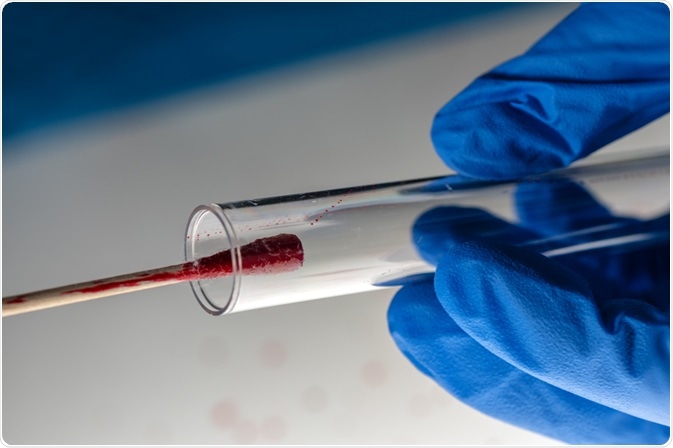Forensic investigation is strongly supported by DNA identification technology. While incredibly useful, these analytical methods are limited in their ability to provide additional information beyond human identification, such as body fluid identification, age prediction and even differentiating between twins.
To overcome these challenges, the evolving field of forensic epigenetics offers forensic investigators more robust and sensitive crime scene evaluations.

Image Credit: igorstevanovic/Shutterstock.com
Limitations of DNA profiling
Some of the advantages associated with DNA profiling for forensic applications are the stability and robustness of DNA profiles that typically do not change over the lifetime of an individual. Furthermore, the DNA profile of an individual will typically remain the same regardless of what body fluid is sampled, except when rare chimerism is involved.
Despite its widespread use and value within forensics, there are certain limitations associated with DNA profiling. For example, although DNA profiling offers greater sensitivity compared to traditional body fluid identification (BFID) methods, it is limited in its ability to provide information on what body fluid the DNA originated from.
In rape cases, the inability to differentiate between a semen sample and a skin sample can be detrimental. Forensic scientists have therefore investigated ways in which epigenomic analyses can successfully overcome such limitations.
What is epigenetics?
By definition, epigenetics refers to the heritable alterations in an individual’s gene expression and phenotypes that result from factors other than changes in their DNA sequence.

Image Credit: kentoh/Shutterstock.com
Some examples of epigenetic mechanisms include DNA base modifications, such as methylation of a CpG DNA region — which contains adjacent cytosine and guanine nucleotides —, post-translational histone modifications (i.e. acetylation or methylation), or RNA-associated silencing.
These epigenetic processes are often the response of both acute and chronic environmental influences that can ultimately lead to the inactivation of genes. The significant impact of epigenetics has caused this area of genetics to be widely studied across scientific disciplines.
Individual epigenetic fingerprints
An individual’s epigenetic fingerprint refers to the epigenomic variation that each individual will experience throughout their lifetime as a result of their lifelong molecular responses to environmental factors.
Within forensics, the detection of an individual’s epigenetic fingerprints is typically achieved by DNA profiling, which is the characterization of short tandem repeats (STRs) or single nucleotide polymorphisms (SNPs).
Over the past several years, significant efforts have been made to allow for the investigation of epigenetic variation by measuring DNA methylation differences between CpG sites.
Applications of forensic epigenetics
Determining body fluids and tissues
In 2011, the first investigation of DNA methylation-based tissues was achieved. Since then, several tissue-specific CpG biomarkers have been developed by numerous companies.
For example, out of the 150 tissue-specific markers identified by the Illumina HumanMethylation450 Beadchip microarray, nine of these are DNA methylation markers that can assist forensic researchers in the differentiation of blood, saliva, semen, vaginal fluid, and menstrual blood samples.
Similarly, eight CpG and two control markers form the basis of an Illumina 450 K 10-plex assay that is based on a methylation-specific restriction enzyme polymerase chain reaction (MSRE)-PCR system.
In addition to the aforementioned methods, several researchers have found that quantitative PCR (qPCR) is a highly sensitive and rapid technique that can be used to identify single-tissue DNA methylation markers. Duplex qPCR methods with two probes capable of identifying non-methylated and methylated alleles at CpG sites have been used for both blood and semen analysis.
Age determination
The ability to determine the age of an individual, both alive and deceased, is an incredibly useful tool during forensic investigations, as well as for the identification of potential criminals. As human beings age, their epigenetic make-up will evolve as a result of their exposure to different environmental factors.
One of the most common applications of epigenetics within forensics is the use of DNA methylation profiling for estimating an unknown individual’s age.
As compared to traditional forensic age predictors that are dependent upon whole blood analyses, the Illumina 450 K microarray platform has successfully identified six CpG regions in saliva samples for age determination.
The success of their technology-led Illumina to develop a novel 7-plex methylation SNaPshot® system, which combined the Illumina 450 K saliva markers with age-associated markers for blood and buccal cell samples as well.
Differentiating monozygotic twins
One of the biggest challenges within forensics is the limited ability to differentiate between monozygotic (more commonly referred to as identical) twins. Since identical twins share almost identical DNA sequences, they will subsequently share practically the same forensic DNA profiles as well.

Image Credit: The Faces/Shutterstock.com
Although ultra-deep whole-genome sequencing has been found to identify individual-specific somatic mutations in SNPs of identical twin subjects, this approach can often be extensive and costly for users.
Forensic scientists have turned to the analysis of epigenetic differences to assist in the discrimination of monozygotic twins. Recent studies on the epigenetic differences of monozygotic twins have demonstrated that both healthy and disease-discordant identical twins will exhibit apparent epigenetic differences, as their environmental exposures and phenotype-related molecular events are likely to vary.
To utilize this information, forensic scientists have employed genome-wide methylation pattern comparisons that found some differences in the CpG sites of a group of 12 twins.
However, due to the small sample size, a much larger study is still needed to confirm the role and function of these altered methylation regions in identical twins.
Sources
- Simmons, D. (2008). Epigenetic Influences and Disease. Nature Education 1(1): 6.
- Vidaki, A., & Kayser, M. (2018). Recent progress, methods, and perspectives in forensic epigenetics. Forensic Science International: Genetics 37; 180-195. DOI: 10.1016/j.fsigen.2018.08.008.
- Williams, G. (2018). The emerging field of forensic epigenetics. Forensic Science International 290; e24-e25. DOI: 10.1016/j.forsciint.2018.07.019.
- Kovatsi, L., Vidaki, A., Fragou, D., & Court, D. S. (2015). Chapter 8 Epigenetic Fingerprint. In Tollefsbol, T. O. Personalized Epigenetics. Elsevier Inc.; 2015:221-239.
Further Reading
Last Updated: Apr 17, 2020